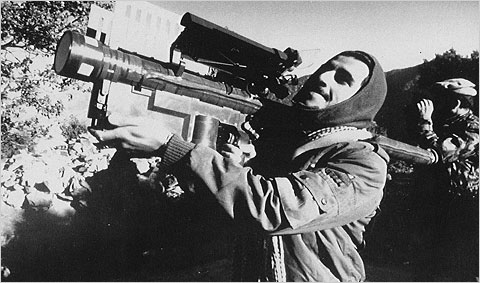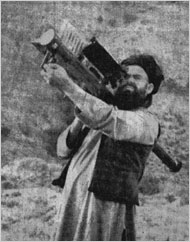The arrests
Wednesday night of four men in New York on their way to an Air
National Guard base with what they thought was a working Stinger
missile reminds your Lede blogger that de spite periodic warnings
that terrorists might try to shoot down commercial jets using
shoulder-fired missiles, only one such attack has even been tried in
recent years. (Luckily, the New York plotters had been given an
inoperable Stinger by someone secretly working with the Federal
Bureau of Investigation.)
In November 2002, a
failed attempt to shoot down a Boeing 757 operated by an Israeli
airline just after it took off from an airport in Kenya prompted a
number of alarming reports in the American media. According to those
reports, there were a
large number of these weapons in circulati on. For years,
intelligence officials had described them as so
easy to use that firing a Stinger was compared with operating “a
point-and -shoot camera.”
Those factors led to a
lot of discussion, in the aftermath of the attack in Kenya,
about the possible need to equip
civilian jets with devices like those used on military aircraft to
fend off missiles. There were also calls to secure
the perimeters of America’s airports, since a federal task force
found that passenger planes “would be vulnerable to attack by
terrorists using shoulder-fired missiles” during take-off and
landing. One would-be pundit even proposed redirecting commercial
air traffic nationwide to impose no-flight
zones over major cities.
Anyone who read and semi-obsessed over these many articles detailing
the threat from these weapon s will also recall that several
hundred Stingers were reportedly left in the hands of the Afghan
holy warriors supplied by the C.I.A. in the 1980s. In 2002, the
Bush administration said Al Qaeda “planned to position”
Stingers, or similar Chinese- and Russian-made SA-7 missile systems
they had trained with, “around the globe.”
So, if this weapon is so powerful and easy to get, why has there
been no wave of terrorist attacks on commercial jets? We called
someone who might know, Milt Bearden, a retired senior C.I.A.
official who ran the agency’s operations in Afghanistan during that
country’s war with the Soviet Union in the 1980s. Mr. Bearden told
The Lede that the fear of terror attacks with Stingers is nearly two
decades old. “When TWA Flight 800 went down, everyone went nuts,” he
recalled, as speculation was rampant that the
jet might have been shot down with a Stinger missile. After
investigators discarded that theory, most Americans forgot about the
shoulder-fired missiles.
Even so, as Steve
Coll wrote in his book “Ghost Wars,” the C.I.A. spent quite a
bit of money buying back as many leftover Stingers as possible from
Afghan warlords during this period, precisely because of the fear
that they might be used against American planes:
After the Soviet troops left, the C.I.A. fretted that loose Stingers would be bought by terrorist groups or hostile governments such as Iran’s for use against American civilian passenger planes or military aircraft. Between 2,000 and 2,500 missiles had been given away by the C.I.A. to Afghan rebels during the war. Many had gone to commanders associated with anti-American radical Islamist leaders [...]Pakistan’s intelligence service handled most of the repurchases on a subcontract basis for the C.I.A. earning an authorized commission for each missile collected [...]The total cash spent by the C.I.A. on Stinger repurchases during the mid-1990s rivaled the total cash donations by other sections of the U.S. government for other humanitarian assistance in Afghanistan during those years by the American government.
In December 2001, Slate
reported that “the Pentagon stated that some 200 to 300 of these
U.S. -made shoulder-launched surface-to-air missiles remained in
Taliban and Al Qaeda hands.” So what happened to them?
According to Mr. Bearden, they are probably just too old to work
properly by now. “The last ones were delivered in 1988,” he told The
Lede, “and its a pretty complex system — a lot of things can go
funky” in 21 years. As for the similar, but older and less advanced
SA-7 model made first by the Soviets, and deployed in the failed
attack in Kenya, he said, “It’s just not a very good weapon.”
Another possible explanation is simply that Stingers and other
shoulder-fired missiles have been used by Islamic militants, but
against American military targets rather than civilian ones. In
Afghanistan and Iraq, reports on the exact causes of helicopter or
jet crashes are hard to come by. In a
recent blog poston the Washington Note, Col. Lawrence Wilkerson,
who was chief of staff to former Secretary of State Colin Powell,
suggested that 200,000 American troops in Iraq and Afghanistan
0present a far more lucrative and close-proximity target for Al
Qaeda than the United States20homeland.” It is certainly possible
that shoulder-fired missiles have caused some of the nearly 5,000
American deaths in those wars.
Another factor might be that sting operations, like the one that
provided the four New Yorkers with a non-working Stinger, are at
least somewhat effective disrupting the trade in these weapons.
Since at least 1990, there have been reports of the F.B.I. breaking
up plots to smuggle Stingers to I.R.A.
guerrillas,Colombian
drug lords and arms
dealers who might have supplied them to terrorists.
Finally, there is of course the
chilling possibility raised by Scott Shugerwriting for Slate in
late 2001 that militants might20simply be still “lying in wait,” for
the right opportunity to shoot down civilian jets and cause chaos.
Mr. Shuger wrote eight years ago:
If I were the last Al Qaeda fighter with a Stinger left in Afghanistan, with the same willingness to die exhibited by the 9/11 gang, I might wait in the weeds — even until long after the war is “over” — for an American plane landing with food packages or a U.S.O. troupe or a delegation from Washington.

